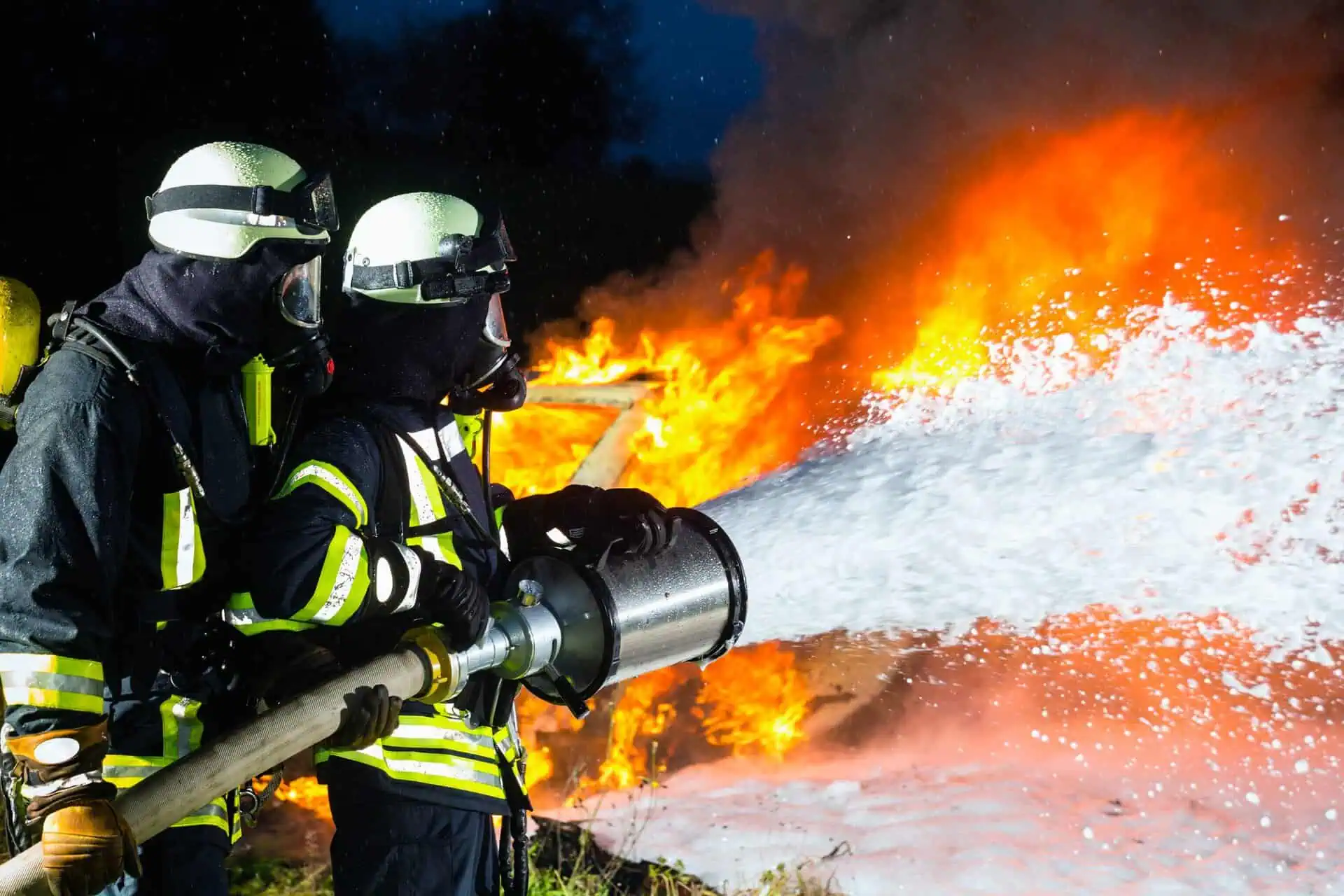AFFF Lawsuit: Shaping Firefighter Safety Standards
- Last Updated: July 14th, 2025

Attorney Jessica Paluch-Hoerman, founder of TruLaw, has over 28 years of experience as a personal injury and mass tort attorney, and previously worked as an international tax attorney at Deloitte. Jessie collaborates with attorneys nationwide — enabling her to share reliable, up-to-date legal information with our readers.
Legally Reviewed
This article has been written and reviewed for legal accuracy and clarity by the team of writers and legal experts at TruLaw and is as accurate as possible. This content should not be taken as legal advice from an attorney. If you would like to learn more about our owner and experienced injury lawyer, Jessie Paluch, you can do so here.
Fact-Checked
TruLaw does everything possible to make sure the information in this article is up to date and accurate. If you need specific legal advice about your case, contact us by using the chat on the bottom of this page. This article should not be taken as advice from an attorney.
Key takeaways:
- The lawsuit links the chemicals in AFFF to certain cancers and other health issues.
- Multiple lawsuits have been filed regarding the use of firefighting foam and the toxic chemicals in AFFF.
- Firefighters are suing AFFF manufacturers over health damages, including increased cancer risk, hormonal imbalances, and organ harm.
AFFF Lawsuit: Shaping Firefighter Safety Standards
On this page, we’ll discuss how the AFFF Lawsuit shapes firefighter safety standards, how AFFF Lawsuits influence training, who qualifies to file an AFFF Lawsuit, and much more.
Intro To The AFFF Lawsuit
Legal actions like the AFFF lawsuit help shape safety standards.
This pivotal shift is continually transforming training programs, strategies around safe handling practices for hazardous materials, better equipment maintenance routines, and facilitating more stringent safety measures aimed at protecting our brave firefighters’ lives and health on duty.
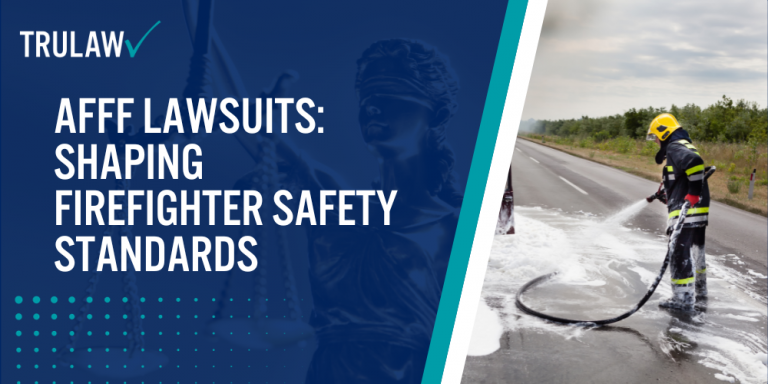
These changes are not only limited to individual fire stations but extend throughout broader community initiatives.
Increased awareness around environmental impacts following contamination incidents involving products such as AFFF leads to more responsible practices regarding storage or disposal methods for hazardous substances used by firefighters worldwide.
Gradually but effectively ensuring compliance with AFFF bans amongst diverse organizations, whether military institutions or airport authorities, especially those that extensively utilized these solutions, also remains indispensable towards maintaining a safer environment free from toxins typically associated with traditional firefighting foams.
Table of Contents
AFFF Lawsuits' Role in Raising Firefighter Safety Standards
These legal actions targeted major manufacturers such as 3M and DuPont, who had been selling the carcinogenic foam.
The link between AFFF exposure and the development of serious health issues like testicular and kidney cancer compelled numerous victims across all 50 states to file suits.
The consequences have been profound on firefighter safety standards, forcing a comprehensive reevaluation and improvement process within fire departments nationwide.
Many departments now prioritize educating their personnel about the potential risks related to toxic chemical exposure from substances like AFFF foams.
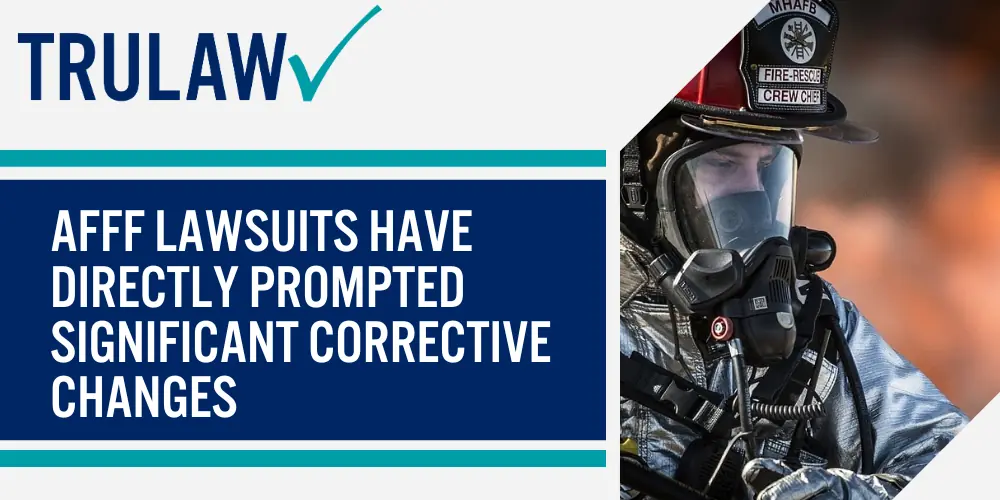
Moreover, it prompted amendments in firefighting protocols, stressing safer alternatives while minimizing occupational hazards linked to potentially harmful firefighting solutions.
While the cost paid due to detrimental effects on human lives needs no articulation.
However, one cannot overlook the course correction ensured through manifold adjustments incorporated thanks to implications arising from AFFF Lawsuits.
These lawsuits functioned as catalysts for change within the firefighting fraternity and in its interactions with society at large step toward a safer tomorrow.
AFFF Lawsuits as Catalysts for Safety Standard Improvements
AFFF lawsuits play a crucial role in enhancing safety standards.
These legal battles shed light on health risks associated with firefighting foams and led manufacturers to focus more on product safety.
Legal cases have also sparked significant shifts in the regulatory landscape surrounding firefighting foams.
In response to PFAS contamination allegations, environmental protection agencies are reevaluating guidelines concerning the use of such products.
This scrutiny leads to a decrease in occupation-related illnesses among these brave personnel who face exposure linked to prostate cancer or kidney disease at higher rates than the general public.
These lawsuits also extend their influence onto training programs.
Firefighters receive education about potential hazards related to aqueous film-forming foam (AFFF) exposure and learn techniques that minimize this risk during operational duties.
Modification of equipment is another area where AFFF litigation results have facilitated advancements.
Manufacturers strive for innovations that limit AFFF contact while ensuring optimal performance amidst high-intensity fire scenarios, ensuring better health safeguards for our front-line heroes without compromising efficiency at work.
Legal Actions and Safety Milestones: AFFF Lawsuit Impacts
The AFFF lawsuit, with over 5,000 cases to date, has marked a critical turning point in firefighting safety regulations.
Legal actions taken against manufacturers of AFFF reveal connections between chemicals used in the foam and several health hazards.
Plaintiffs allege that exposure to PFAS chemicals in AFFF products led to cancers and other severe health concerns, sparking changes across the industry.
Settlement discussions send ripples through various aspects of firefighting operations—from equipment updates to training adaptations.
Lawsuits against manufacturers have driven advancements in firefighter gear aimed at reducing hazardous exposure.
New training programs encourage practices free of AFFF usage while enhancing safety protocols.
Legal considerations influence direct safety measures and broader environmental responsibilities linked with fire service duties.
The lawsuits have heightened awareness regarding properly disposing of toxic materials like AFFF and mitigating risks to personal health and surrounding communities.
Moreover, these legal milestones have inspired more rigorous compliance initiatives adhering strictly to bans on harmful substances such as those found in AFFF.
Lessons from AFFF Lawsuits: Elevating Firefighter Safety
The AFFF lawsuits have dramatically influenced the firefighting industry, catalyzing significant safety protocol and practice changes.
These lawsuits have underscored a critical connection between firefighter health risks and using aqueous film-forming foam (AFFF).
Such litigation has pushed for increased regulation and strengthened safety standards.
The discovery of high amounts of toxic chemicals in firefighters’ gear prompted significant action toward reducing occupational exposure to harmful substances.
Their impact is visible in the industry’s swift transition towards safer AFFF alternatives.
Today, there is a heightened focus on proper AFFF disposal laws ensuring firefighter safety while minimizing environmental contamination.
Equipment evolution driven by these lawsuits now involves more rigorous testing for toxic compounds, pushing manufacturers toward innovative solutions that prioritize firefighter wellness over anything else.
Tactical adaptations in response to lawsuits are other key components enhancing safety protocols within fire service institutions.
There is an increased emphasis on training regarding safe handling practices of potential hazards, such as PFAS-laced firefighting foams around active fire scenes.
Setting aside legal considerations like liability and compliance associated with improper disposal or handling habits.
Cultural transformations at grassroots levels are set into motion post-AFFF lawsuit settlements advocating prioritization of health concerns during decision-making processes within firefighting culture.
AFFF Lawsuits and Firefighter Health and Safety Evolution
Once considered a vital tool in combating fires, AFFF (Aqueous Film Forming Foam) is now at the center of numerous AFFF lawsuits due to its harmful impact on firefighter health and safety.
Groundbreaking studies have exposed that chemicals present in this foam, such as PFAS (Per- and Polyfluoroalkyl Substances), can lead to several types of cancer, including kidney, testicular, and prostate cancer.
Consequently, these revelations sparked lawsuits against major manufacturers like DuPont and 3M, resulting from their failure to disclose potential health risks associated with the product.
The ongoing legal actions surrounding AFFF highlight an urgent need to revamp safety standards within firefighting practices.
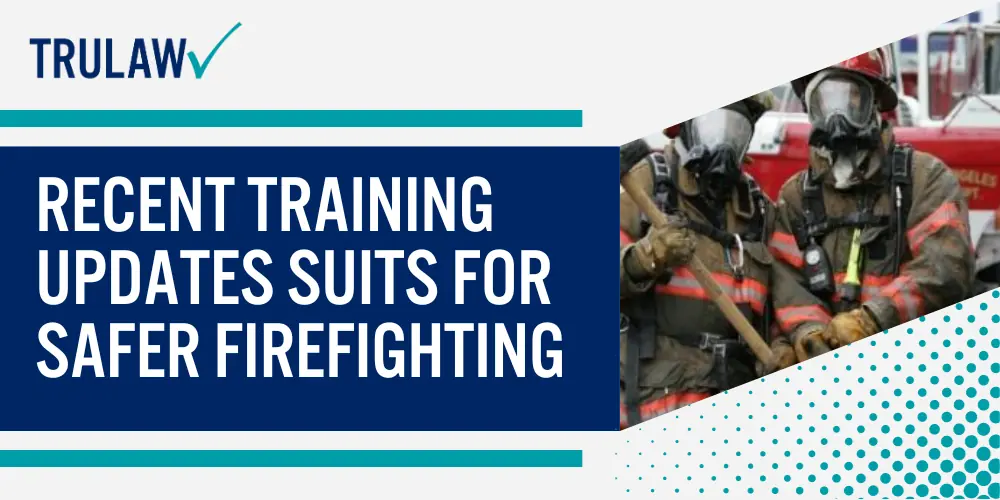
In response, firefighters are being educated about safer alternatives while firefighting organizations strive towards attaining AFFF-free environments during training activities.
Recent training programs reflect regulatory changes inspired by these landmark suits, ensuring safer firefighting methods.
Meanwhile, technological advancements deliver innovation in equipment design to minimize exposure risk even further.
Furthermore, these developments underscore environmental responsibility where disposal procedures are concerned – another crucial aspect influenced by AFFF lawsuits.
Notably, informed adherence to new regulations serves dual roles: it complies with laws encompassed within the fallout of the AFFF controversy while simultaneously enhancing firefighter safety measures, making compliance a matter of legality and one of life preservation.
Lastly yet important is the cultural shift spurred by these events, a movement towards greater transparency and commitment to wellness among personnel.
This is a testament to how adversity often paves pathways for evolution, turning challenges into catalysts for change.
From Exposure to Protection: AFFF Lawsuits and Health Safeguards
As an outcome of nationwide AFFF lawsuits, the focus on firefighter health protection has significantly increased.
These legal actions have highlighted the severe health risks associated with exposure to AFFF firefighting foam.
As a result, safety standards for firefighters are shifting from mere exposure management to rigorous protection measures.
AFFF lawsuits have instigated greater diligence about potential health threats that this foam presents.
Attention has shifted towards minimizing exposure and offering immediate treatment if contact occurs.
The emphasis is now on equipping firefighters with enhanced protective gear and training them in procedures that limit their interaction with harmful substances.
The global impact of these lawsuits transcends beyond individual healthcare; they underline the grave environmental issues linked to AFFF usage.
Hence, best practice regulations for AFFF disposal are being implemented worldwide, exercising caution and caring for the broader ecosystem’s well-being.
In essence, these litigations were catalysts advocating adopting eco-friendly firefighting methods and promoting responsible environmental behavior among firefighters.
Community initiatives are springing up across regions affected by water contamination due to inappropriate disposal of used AFFF foams, further evidence of how positive change can evolve from difficult situations like litigation battles over hazardous materials handling practices.
Firefighter Wellness Programs: An Outcome of AFFF Lawsuits
AFFF lawsuits have played a significant role in creating and expanding firefighter wellness programs.
These legal battles highlighted the stark health risks associated with AFFF exposure, urging departments across all 50 states to prioritize their teams’ overall well-being.
The litigation revealed manufacturers’ irresponsibility in producing carcinogenic AFFF and its detrimental effects on firefighters’ health.
The knowledge from these cases propels new safety measures forward.
Fire departments now take proactive steps toward reducing potential future hazards by discontinuing the use of PFAS-containing firefighting foams and implementing stringent safety protocols for foam disposal.
Wellness initiatives have evolved, encompassing not just physical fitness but also mental health support along with regular screenings for diseases linked to AFFF exposure, like prostate cancer, kidney cancer, and more.
In response to growing concern over adverse health effects from occupational exposures such as toxic chemicals in AFFF firefighting foam, various legislative actions put forth personal injury claims against companies known for producing this harmful agent.
This has led to broader discussions about municipal water contamination cases, which drove environmental protection agency involvement, lending further transparency regarding potential harm caused by such substances within our environment.
These developments fundamentally reshape how firefighters approach their own wellness while setting remarkable precedents concerned primarily with justice for affected individuals, all due to ongoing litigation around harmful substances found within commonly used firefighting agents.
The Changing Landscape: Health Prioritization Post-AFFF Lawsuits
The significant wave of AFFF lawsuits has ignited an essential shift in health priority within the firefighting industry.
This legal uproar has not only sought compensation for cancer victims but also signifies a recognition of harm inflicted and emphasizes the need for stringent health safeguards.
AFFF-related cancer cases are on the rise, with North Dakota serving as a prime example of this alarming trend.
Encouragingly, judicial responses have been swift and decisive in many instances, showing growing commitment towards protecting public health.
The expected AFFF settlement in 2023 might cement this commitment by holding manufacturers accountable and calling for safer firefighting practices.
AFFF Lawsuits: Influencing Training for Enhanced Safety
Legal action against Aqueous Film Forming Foam (AFFF) manufacturers has impetus for change in training protocols.
An increased understanding of the risks associated with AFFF exposure has led to an overhaul of firefighting procedures and practices.
Training programs now include comprehensive safety modules highlighting the hazards of AFFF foam.
Since these lawsuits came to light, fundamental changes have been observed in firefighter induction and on-the-job training.
Updated training regimes emphasize personal protective equipment (PPE), stressing its importance in mitigating health risks from toxic substances like AFFF.
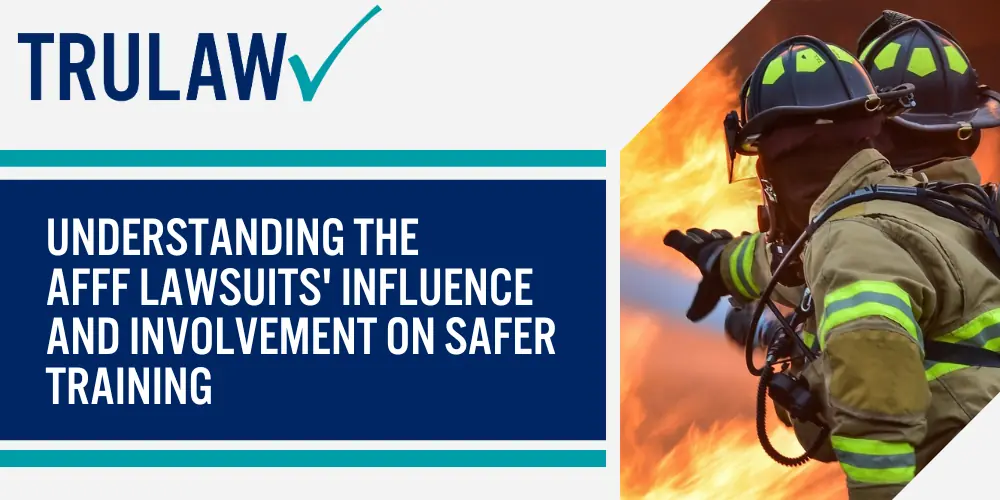
The controversy surrounding this substance has prompted trainers to educate firefighters about safer alternatives available in case they encounter similar, potentially hazardous materials during their work.
Moreover, environmental science education is increasingly becoming a component of firefighter development programs because of the attention brought by these lawsuits.
This initiative aims to raise awareness about the potential environmental impact of firefighting chemicals, ultimately empowering firefighters with knowledge to help them make more informed decisions during operations and emergencies.
Training for AFFF-Free Practices: An AFFF Lawsuit Legacy
Understanding the legacy of AFFF lawsuits requires a deep dive into their influence on firefighter training for safer, AFFF-free practices.
Crucial steps and considerations for AFFF Practices and training include:
- Fire departments nationwide have been implementing new training protocols emphasizing safety without AFFF in response to the recognized health risks from AFFF exposure.
- These revised training programs actively educate firefighters on the hazards of PFAS chemicals commonly found in traditional AFFF firefighting foam.
- The updated curricula include alternative fire suppression methods, such as water-based techniques or new, non-toxic foams, without using toxic firefighting foam.
- As part of these training adjustments, firefighters are instructed to handle previous AFFF supplies properly, adhere to disposal laws, and ensure minimal environmental impact.
- The focus has shifted toward compliance with newly introduced AFFF bans to ensure safe firefighting practices and safeguard against potential litigation related to AFFF exposure.
- Legacy effects of these lawsuits have seen fire departments moving towards innovative gear and equipment free from harmful substances such as PFAS.
- Training now includes lessons learned from prior mass tort cases involving exposure-related personal injury claims, pushing for awareness of occupational exposure dangers and vigilant safety standards.
AFFF Lawsuit Outcomes and Training Adjustments
Legal outcomes of the AFFF lawsuits are prompting landmark changes in firefighter training.
Adjustments aim to minimize exposure to potentially harmful chemicals in firefighting foams like AFFF.
Crucial steps in this transformation revolve around redefining emergency response routines and adopting safe practices.
Training programs now place a heightened emphasis on occupational health risks associated with toxic substances, such as those found within aqueous film-forming foam (AFFF).
There’s a strong push towards focusing more on chemical safety education.
Equipping firefighters with knowledge about PFAS-based hazards contributes to improved site safety.
Tools, techniques, and protocols are also under review as part of the shift away from using hazardous firefighting foams.
Innovations arise from an urgent need for effective but safer alternatives to suppress jet fuel fires without endangering firefighter health or contaminating water supplies.
The ripple effect of these improved standards goes beyond individual fire services.
By prioritizing compliance with AFFF bans while ensuring rigorous adherence to enhanced safety protocols, broader community health safeguards become firmly rooted within the firefighting culture.
Safety-Driven Training: AFFF Lawsuit-Induced Enhancements
The legal repercussions of AFFF lawsuits have accelerated improvements in firefighter safety training.
This shift emphasizes the importance of safeguarding the health and well-being of frontline heroes.
The heightened awareness has necessitated changes in how fire departments deal with firefighting foams containing per- and polyfluoroalkyl substances (PFAS), revealing a clear correlation between these legal cases and better training protocols.
One critical aspect is the reduced use of traditional firefighting foams, specifically those containing PFAS chemicals.
These harmful compounds are present in AFFF, which studies reveal can be found in high levels on firefighters’ equipment.
Their potential for harm amplifies the need for revamped safety measures during practice drills and real-world emergency responses.
Furthermore, as an offshoot of these lawsuits, there’s been increased attention to safer disposal methods for used fire suppression agents such as AFFF.
Fire departments now implement specialized handling procedures that minimize personnel exposure to potentially dangerous materials.
Simultaneously, gear selection criteria have incorporated considerations around their resistance or porousness to PFAS penetration – enhancing overall firefighter protection during operations.
AFFF Lawsuits and Safe Environmental Impact Awareness
AFFF lawsuits have been central to raising awareness about the environmental impacts of firefighting foam.
The toxic chemicals in AFFF, such as PFAS, harm firefighters and pose a significant environmental danger.
Manufacturers like 3M and DuPont are held accountable for manufacturing and selling carcinogenic AFFF through litigation processes.
These actions result in stricter regulations on its use, storage, and disposal.
Community safety initiatives sparked by these lawsuits advocate for more responsible environmental practices within the fire service industry.
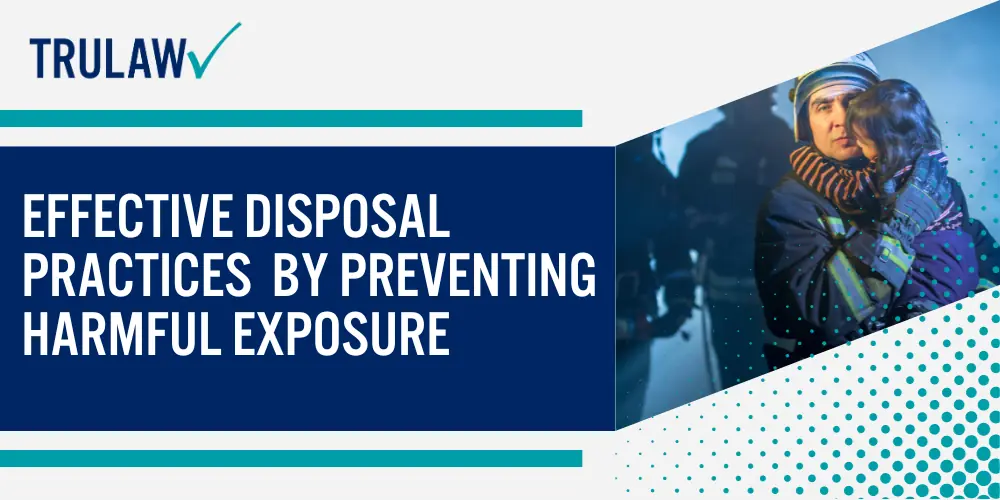
Education becomes key; knowledge about AFFF contamination helps firefighters handle this hazardous material better, ensuring their own protection and preserving our ecosystem’s health.
Disposal best practices mitigate risks posed to firefighter safety by guiding effective protocols that avoid harmful exposure.
Similarly emphasized is an equipment evolution driven by these lawsuits, which calls for innovative gear restrictions promoting safer firefighting alternatives free from toxic substances.
This pursuit encourages adaptive strategies reshaping firefighting protocols towards enhancing safety measures alongside ensuring robust compliance with new mandates resulting from AFFF bans.
Further extending its influence beyond ecological implications—leads to crucial shifts within fire service culture, fostering a platform prioritizing health efforts resulting from identified potential dangers related to AFFF exposure.
A testament demonstrates how legal processes can positively impact both occupational health & environmental welfare standards simultaneously.
AFFF Contamination Awareness: Linking Environmental Impact to Safety
Surrounding areas often experience the environmental fallout of AFFF use.
For instance, military bases utilizing this foam have caused significant water supply pollution due to PFAS contamination.
This concern extends beyond these areas, impacting communities with potential health risks associated with chronic exposure to contaminated water.
Firefighters using AFFF during training drills don’t just face personal occupational exposure risk.
Their actions also have broader implications as the foam can penetrate the soil and gradually release hazardous pollutants into the environment over time.
These persistent toxins contribute to a continuous contamination cycle affecting humans and wildlife.
Furthermore, litigation against manufacturing companies like 3M and DuPont suggests their role in exacerbating environmental harm through the unabated production of carcinogenic AFFF.
Community Safety Initiatives: AFFF Lawsuits and Environmental Advocacy
AFFF lawsuits have significantly influenced safety initiatives within communities.
Legal actions against manufacturers of AFFF foam send a strong message about the importance of public health and environmental responsibility.
These lawsuits raise awareness about the harmful effects of PFAS chemicals in firefighting foam.
The litigation process has prioritized firefighter health and emphasized their role as stewards of the environment.
Firefighters are now more educated on how to dispose of AFFF materials and minimize contamination risks safely.
This increased knowledge lessens potential harm to firefighters and the wider community, leading to robust safety standards enforced by accountable institutions.
These legal battles have also sparked critical discussions about sustainable practices in fire service departments across various jurisdictions.
Many facilities are adopting safer alternatives to toxic foams that align with stricter environmental regulations and guidelines.
Consequently, an era has been ushered in where community safety is secured without compromising environmental integrity.
Educating Firefighters: AFFF Lawsuits and Environmental Responsibility
Revelations from AFFF lawsuits have paved the way for critical environmental education among firefighters.
Tainted with dangerous PFAS chemicals, firefighting foam was a crucial safety concern in these suits.
Over 4,790 plaintiffs exposed to this toxic substance sued the manufacturers who allegedly knew about its hazards but continued production nonetheless.
These court actions opened up conversations regarding protective measures and responsible practices in firefighting.
This newfound attention to environmental responsibility means adjustments in firefighter training routines across the US.
Now, they learn not just how to douse fires effectively but also how to safely manage and dispose of AFFF post-incidents.
Awareness related to PFAS contamination has helped reduce risk factors linked with occupational exposure during fire suppression activities or routine training exercises involving aqueous film-forming foams (AFFF).
Moreover, equipment upgrades influenced by lawsuit outcomes ensure further protection from harmful substances for firefighters and those they serve.
Emphasizing environmental stewardship reflects an evolution of fire service culture brought about by legal battles by affected individuals against unconcerned AFFF manufacturers.
This cultural shift stresses more than ever that safeguarding firefighter health heavily intertwines with conscious efforts aimed at reducing the hazardous impact on our surroundings.`
AFFF Foam Disposal for Firefighter Safety
A significant part of firefighter safety revolves around correctly disposing of Aqueous Film Forming Foam (AFFF).
This toxic foam, laden with PFAS chemicals, is under strict scrutiny due to its link with adverse health effects.
Regulations and best practices for safe disposal are continually developing due to ongoing AFFF lawsuits, spotlighting the pressing need for responsible management.
Complying with these standards protects firefighters and mitigates environmental risks associated with improper AFFF disposal.
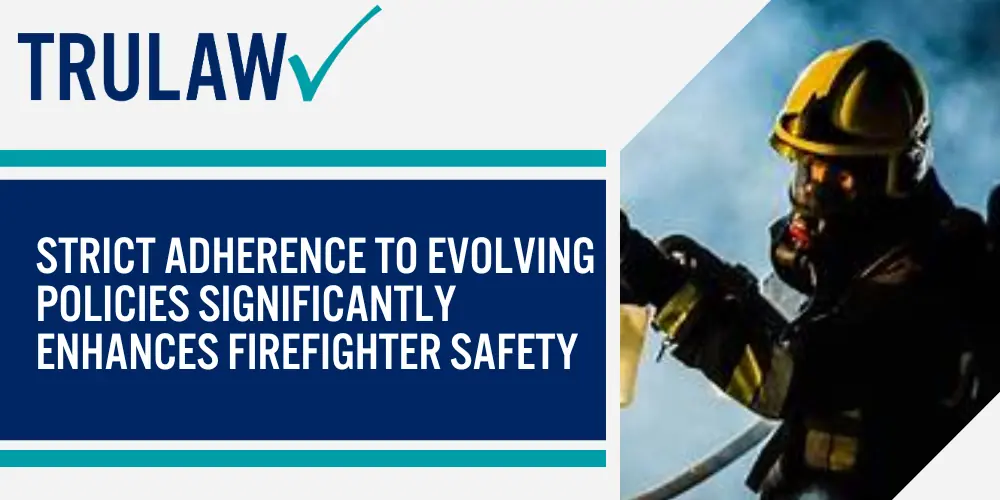
Every step is critical in ensuring comprehensive protection, from handling protocols to storage and eventual destruction procedures.
Constant vigilance and adherence to these evolving policies are instrumental in elevating firefighter safety levels.
Navigating AFFF Disposal Laws: Ensuring Firefighter Safety
Understanding and adhering to AFFF disposal laws is critical to enhancing firefighter safety.
These laws specify the protocols for handling and disposing of firefighting foam, intending to reduce potential risks linked to exposure.
Following these guidelines ensures firefighters stay safe while protecting others from the dangers of fires.
AFFF lawsuits have significantly changed how this hazardous material is treated.
The disputes highlight the fatal health effects on firefighters caused by toxic chemicals present in AFFF, primarily PFAS substances.
In response, regulatory authorities have tightened their grip on AFFF disposal requirements.
Enforcing stringent rules for safely discarding used AFFF is pivotal in reducing contamination levels and safeguarding those at risk.
Fire departments must map out comprehensive plans around proper disposal methods based on recommended practices underlined by environmental protection agencies.
Developing and applying protective measures like decontamination kits, equipment upgrades, and training programs tailored to PFAS-free firefighting techniques ensures firefighter safety post-AFFF litigation events.
Fire departments must familiarize themselves with these laws and maintain compliance to prioritize firefighter wellness and overall community health.
Liability and Compliance: Legal Considerations in AFFF Disposal
Legal responsibility in AFFF disposal comes with navigating complex rules set forth by various regulatory bodies.
Firefighting departments and private entities using AFFF are required to comply meticulously, thus shaping their waste management strategies.
Disregarding these can lead to significant legal issues, including hefty fines or lawsuits.
Understanding compliance complexities is crucial for maintaining a robust waste-handling system.
Stringent regulations involve the appropriate identification, segregation, containerizing, labeling, and proper record-keeping of hazardous materials like PFAS found in firefighting foams.
Any breach could expose organizations to severe consequences under environmental laws.
Transitioning away from AFFF requires attention to choosing suitable substitutes and a careful focus on disposal concerns for remaining stockpiles of foam containing PFAS chemicals.
Various states have enacted or proposed regulations tackling this issue.
Firefighting stations must seek expert advice when dealing with the disposal of toxic substances like AFFF.
They should ensure that their disposal partner understands the legalities involving such wastes and adheres strictly to best practice guidelines for safe and compliant removal.
The key takeaway is that negligence is not an option when dealing with substances as hazardous as AFFF- it’s about firefighter safety today and safeguarding generations yet unborn.
Disposal Best Practices: Mitigating Risks to Firefighter Safety
Effective disposal of Aqueous Film Forming Foam (AFFF) typically consists of:
- Determining the type of firefighting foam: Identify whether it contains Perfluoroalkyl and Polyfluoroalkyl Substances (PFAS), harmful chemicals linked to health issues.
- Store safely before disposal: Seal AFFF containers properly, limiting the possibility of leaks or spills that could cause contamination.
- Implement designated disposal procedures: Follow state regulations and guidelines for disposing of AFFF, as these vary across jurisdictions.
- Engage licensed waste disposal companies: Rely on professional services for safe and compliant waste management and disposal efforts.
- Schedule regular pickups or drop-offs: Coordinate with waste disposal facilities regularly to ensure timely removal of stored materials.
- Document every process: Maintain comprehensive records of storage and disposal activities, ensuring traceability and accountability.
- Stay updated on regulatory changes: Monitor updates in local, state, or federal laws governing AFFF usage and disposal to ensure full compliance.
AFFF Lawsuits Advancements in Firefighter Equipment
Firefighter gear and equipment have seen radical transformations due to AFFF lawsuits.
As revealed by extensive research, these legal battles shed light on the dangerous amounts of PFAS chemicals in firefighter outfits and safety gadgets.
This revelation was a wake-up call for manufacturers, sparking an industry-wide commitment to produce safer alternatives.
Technology has been instrumental in achieving these necessary safety upgrades post-AFFF lawsuits.
Innovations now offer safer firefighting equipment without compromising functionality or effectiveness.
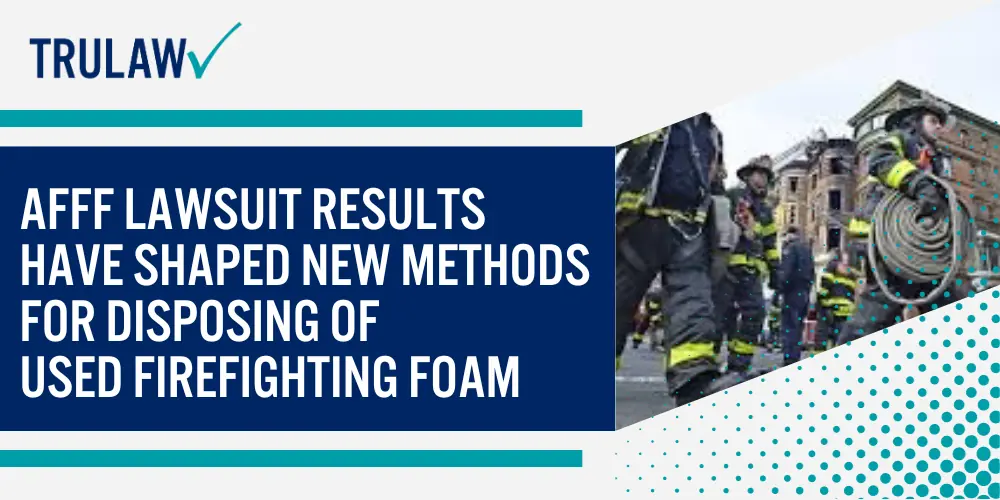
Developments range from flame-resistant clothing treated with non-toxic substances to advanced helmets that block harmful UV rays.
AFFF litigation outcomes have also influenced new strategies for managing used firefighting foam disposal.
With stricter regulations governing the safe handling of this toxic substance, firefighters are better equipped to maintain their health while protecting communities from fires.
The outcome is a profound cultural shift within fire services towards prioritizing environmental responsibility and health safeguards above all else.
Innovative Gear: Enhancing Firefighter Safety Post-AFFF Lawsuits
Emerging from the ashes of AFFF lawsuits, revolutionary gear is taking center stage to bolster firefighter safety.
Manufacturers now prioritize health protective innovations, spurred by legal actions highlighting firefighting foams’ hazardous implications.
Multifunctional helmets with built-in thermal cameras are fast becoming a standard part of their toolkit.
These devices allow firefighters to navigate smoke-filled environments more safely and swiftly find needy victims.
The evolution does not stop there; innovative respiratory equipment also plays a crucial role in minimizing on-the-job risks for first responders.
Introducing lighter air tanks and advanced face masks, offering improved visibility and communication abilities, significantly reduces exposure to toxic substances like PFAS associated with AFFF use.
Beyond personal safety gear, strategic modifications extend to firefighting vehicles too.
Modern fire engines are increasingly equipped with foam proportion systems that precisely control foam concentrate injection rates.
This new technology minimizes the potential overuse or mishandling of foam-based suppressants, thereby reducing detrimental environmental impacts linked to contamination events resulting from AFFF use.
As progress continues post-AFFF lawsuits, updated protocols compliant with regulations banning the toxic substance have become an industry norm, fostering heightened awareness about firefighter wellness initiatives along the way.
Equipment Evolution: AFFF Lawsuit-Driven Advancements
The legal battles surrounding AFFF firefighting foams have sparked significant advancements in equipment technology and safety protocols.
The revelation of high levels of PFAS chemicals in traditional gear compelled manufacturers to innovate, leading to the development of safer alternatives.
This ongoing transformation ensures that firefighters no longer need to choose between their personal health and public service.
Not merely limited to personal protective gear, AFFF lawsuit-driven changes extend across various facets of firefighting operations.
For example, fire departments now implement modified training programs emphasizing safe handling and disposal procedures for foam residues containing toxic substances.
Equally fundamental are the progressive strategies deployed by fire truck builders working tirelessly towards creating vehicles designed with compartments specifically built for disposing of harmful remnants after a fire has been extinguished.
This dynamic shift underpins the determination to prioritize firefighter safety without compromising efficiency or effectiveness.
It proves that despite adversity, there is an opportunity for positive change, fostering a safer professional environment for those who risk their lives protecting others.
Safety-First Technology: AFFF Lawsuit Impact on Equipment Upgrades
The AFFF lawsuit has sparked significant changes in the firefighting industry, particularly with respect to equipment upgrades.
Manufacturers are now under pressure to produce firefighting foams that do not contain PFAS chemicals.
This shift is in response to findings from the lawsuit, which revealed harmful amounts of these chemicals within firefighters’ safety gear and equipment.
These revelations have prompted companies to rethink their approaches, leading them towards safety-first technologies.
Safety-focused innovations are changing the chemical makeup of firefighting foam and enhancing protective clothing for firefighters.
The toxic influence of PFAS-containing AFFF on firefighter wellness led to outcries for safer fire suppression methods and better protection tools.
Equipment manufacturers responded by improving suits and helmets with advanced materials to defend against health-hazardous contaminants.
The impact is clear; legal actions concerning AFFF exposure considerably improved firefighter gear and safety protocols.
Stricter standards now apply regarding what constitutes acceptable firefighter equipment, fostering a new era where ‘safety first’ isn’t just a slogan but an integral part of technology development in this sector.
AFFF Lawsuits Adaptive Strategies in Reshaping Protocols
Firefighting departments nationwide are reassessing and modifying their protocols in response to AFFF lawsuits.
These legal actions have highlighted the need to properly handle chemical-laden firefighting foams and equipment to protect personnel health.
The implications on firefighter practices became evident after allegations linking PFAS exposure through AFFF products with serious health issues surfaced in multidistrict litigation.
Adaptive strategies involve enhancing safety training, pushing for more robust equipment inspection routines, and transitioning towards PFAS-free fire suppressants.
Departments nationwide prioritize compliance with regulations regarding AFFF bans while maintaining an uncompromised approach toward firefighting efficiency and effectiveness.
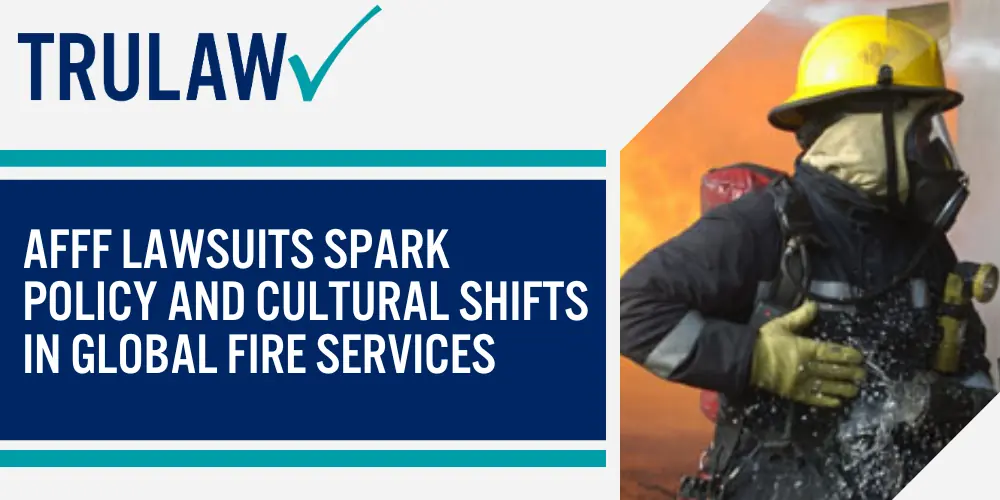
This shift postulates a reimagined environment that values firefighter safety and tactical proficiency during emergency service operations.
Legal factors intertwined with health concerns shape these adaptive strategies, fostering a paradigm shift in firefighting culture by integrating safety-centric modifications into traditional practices.
In essence, AFFF lawsuits drive major reforms within policies and influence cultural transformation across fire services globally.
AFFF Lawsuits and Tactical Adaptations: Enhancing Safety Protocols
AFFF lawsuits are a tangible driver behind the significant evolution of firefighter safety protocols.
These legal proceedings have inspired considerable changes, bringing to light the dire consequences of AFFF exposure and pushing firefighting departments nationwide to adapt their tactics.
The focus has shifted toward minimizing contact with hazardous substances, equipping personnel with protective gear, practicing safe disposal methods, and advocating for non-AFFF firefighting alternatives.
Simultaneously, firefighter training is undergoing substantial modifications.
Traditional practices using AFFF are being replaced by comprehensive lessons on understanding potential health risks associated with chemical exposure and handling safer fire suppression agents.
Furthermore, compliance following bans on toxic foams has become an integral part of these adaptations, emphasizing adherence to regulations as a crucial aspect of safeguarding firefighters’ well-being.
Flexibility in Firefighting: AFFF Lawsuits-Driven Protocol Adjustments
Safety in firefighting has significantly evolved due to AFFF lawsuits, leading to necessary adjustments in protocol.
Flexibility is paramount as these litigations highlight the potential health risks of AFFF exposure.
Firefighting departments are now phasing out airport firefighting foam containing carcinogenic compounds, such as PFAS.
This step comes as firefighters face an increased risk of developing cancer and other serious diseases from exposure.
Innovative tactics are being embraced by fire departments across America, driven predominantly by revelations from the AFFF lawsuits.
Waco Fire Department’s initiative marks a notable shift towards safer practices in firefighting operations.
Protocols now emphasize minimizing PFA exposure without compromising efficacy against jet fuel fires.
Moreover, equipment manufacturers are tasked with designing products that support these revised protocols.
These developments signal transformational change within the firefighting culture- moving away from traditional techniques while incorporating safety-first methodologies into daily operations and training processes.
The evolution spurred by the ongoing legal actions represents considerable progress toward ensuring firefighter health and environmental safeguards.
AFFF Lawsuit Firefighting: Compliance, Regulations, and Safety
Legal proceedings surrounding AFFF (Aqueous Film-Forming Foam) have directed attention toward compliance with new firefighting regulations and safety procedures.
States across the US are enacting stringent rules in response to growing health concerns tied to PFAS chemicals found commonly in AFFF, equipment, and gear used by firefighters.
These moves reinforce firefighter wellness while ensuring fire services conform to safer industrial practices.
Emerging from a backdrop of increased scrutiny due to lawsuits, the manufacturers face pressure on multiple fronts – from product reformulation requirements to improved disposal methods for spent materials.
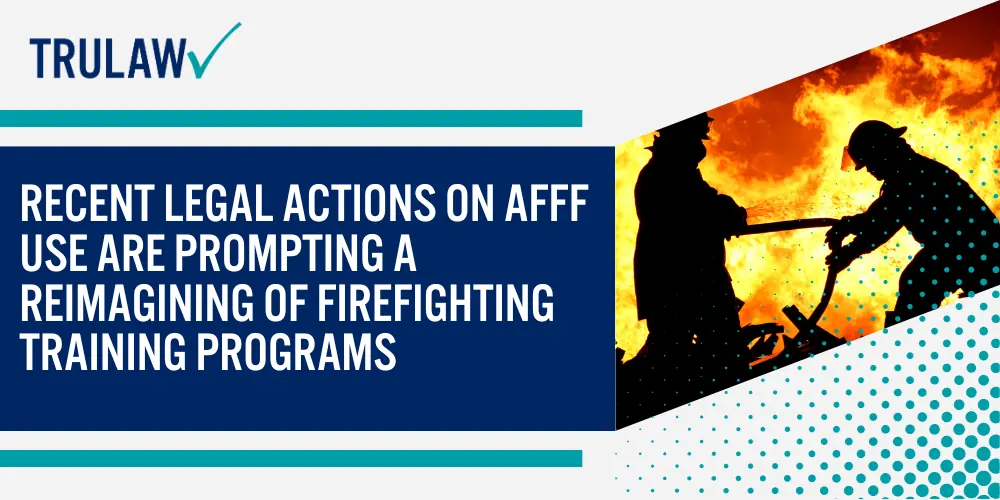
In numerous cases such as AFFF Firefighting Foam MDL–consolidated litigation for personal injury and water contamination against manufacturers, it was discovered that manufacturers were aware of potential health risks yet continued production unabated.
Thus, regulatory bodies have recently significantly stepped up their oversight functions in implementing preventive measures to safeguard our brave firefighters and protect communities from harmful exposures.
In light of recent developments catalyzed by legal actions relating to AFFF use, firefighting training regimes are being re-envisaged.
Adjustments entail teaching personnel about practices devoid of PFAS-laden substances while emphasizing strict adherence to pollution control laws during routine exercises or emergencies.
The intersection between ongoing lawsuits and an evolving culture within fire service is influencing sweeping shifts toward a more safety-conscious workforce environment.
These changes denote stepping stones towards fostering a healthier work atmosphere for those directly and indirectly involved with firefighting activities, thereby tangibly demonstrating how legal actions can instigate systematic change in industries facing public health issues.
Compliance with AFFF Bans: Ensuring Safe Firefighting Practices
Emerging fire safety policies require strict adherence to AFFF bans driven by significant exposure to health hazards.
These restrictions maintain a clear focus on firefighters’ well-being and the environment.
Adherence can be challenging but not impossible; it calls for drastic changes in firefighting tactics.
Tyco Fire Products, a significant AFFF manufacturer, decided to end production of these foams after understanding their potential harm.
States also took action against AFFF use in training or testing scenarios by implementing regulations that ban such activities.
This approach aligns with the goal of prioritizing firefighter health while reducing environmental contamination.
Innovations are coming into play as substitutes for AFFF gain traction in the firefighting industry.
Manufacturers now provide biodegradable foam concentrates as more sustainable substitutes for traditional firefighting practices – proving that compliance doesn’t have to mean compromise.
Also, continuous education programs serve as platforms where firefighters learn about safer alternatives to toxic substances like AFFF without sacrificing efficiency during emergencies.
Such initiatives reinforce the importance of protecting lives while respecting our shared ecosystem’s fragility.
Regulatory Landscape Post-AFFF: Prioritizing Firefighter Safety
Legal reforms are transforming the firefighting landscape following the AFFF lawsuit.
Government bodies and fire departments across the United States are adopting proactive policies to minimize health hazards from firefighting foam chemicals.
These regulations address matters ranging from proper gear use and operational protocols during fire incidents to safer disposal methods of contaminated items.
High on the safety priority list is reducing firefighters’ contact with toxic firefighting foam like AFFF.
Groundbreaking inventions in firefighting equipment ensure reduced exposure to harmful substances while effectively combating flames.
Additionally, comprehensive training programs educate firefighters about potential health risks associated with PFAS chemicals in legacy AFFF foams.
Lawmakers and environmental agencies play crucial roles within this evolving regulatory framework.
Policies around managing PFAS contamination reflect a commitment towards public well-being over the commercial interests of manufacturers such as 3M Co et al., which are initially responsible for developing these hazardous foams.
Armed with robust data-driven research, they aim to legislate decisive steps protecting vulnerable communities against potential water contamination from incorrect AFFF disposal procedures.
These transformations illustrate how legal actions like the AFFF lawsuit shape industry regulations, guaranteeing enhanced safety standards for first responders and their local municipalities.
AFFF Lawsuits and The Intersection and Fire Service Culture
In the wake of AFFF lawsuits, the fire service culture has undergone significant changes.
Key learnings from legal actions force a rethink of standards, practices, and attitudes toward safety within these service communities.
Fire departments nationwide now focus more on health risks associated with occupational exposures to harmful chemicals like PFAS.
These transformative shifts in tradition-bound firehouse cultures have their roots in hard-learned lessons from AFFF-related litigation.
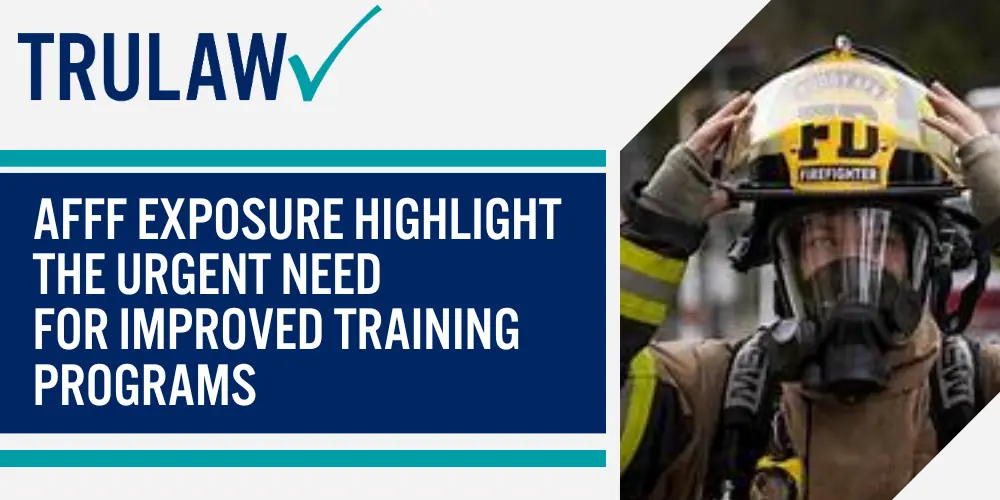
Safety is no longer viewed as only about active firefighting tasks but extends to acknowledging and mitigating long-term health hazards linked to equipment usage and disposal methods.
This has initiated much-needed conversations around creating a safer environment for firefighters by choosing less harmful alternatives for firefighting foams.
Furthermore, legal actions related to AFFF exposure highlight the urgent need for improved training programs.
These initiatives aim to foster adherence to safer practices while handling chemical-laden firefighting foams, a direct offshoot of learning from AFFF lawsuit experiences.
Lastly, heightened awareness about environmental sustainability within community-based firefighter units also signifies growing maturity in understanding the interconnectedness between individual safety parameters and wider environmental impacts brought forth by these lawsuits.
For instance, appropriate disposal or treatments are not merely compliance issues but translate into concrete actions preserving both firefighter’s wellness and community well-being.
AFFF Lawsuits as Catalysts for Cultural Shifts in Fire Service
AFFF lawsuits spurred significant reforms in fire service operations by highlighting the dangers associated with AFFF firefighting foam.
The lawsuits have clarified that firefighters’ safety standards can and should be improved, leading to a widespread cultural shift within the industry.
The allegations against manufacturers – who reportedly knew about the risks associated with AFFF foam for decades but failed to warn users triggered drastic changes.
Fire departments began prioritizing firefighter health and implementing wellness programs.
Furthermore, these legal cases led to major advancements in equipment used, ensuring better protection against harmful substances.
In response to the concerning data linking AFFF exposure and serious medical conditions such as cancer, fire services have also adopted innovative training practices aimed at minimizing contact with toxic substances.
This has prompted an environmental responsibility drive among firefighters.
Finally, compliance regulations from these lawsuits shaped new protocols for safely disposing of potentially harmful materials like AFFF foam.
These changes epitomize how AFFF lawsuits acted as catalysts for much-needed shifts in fire service culture towards prioritizing firefighter health above all else.
Cultural Transformation: AFFF Lawsuit Influences on Firefighting Culture
The aftermath of AFFF lawsuits has sparked remarkable transformations in firefighting culture globally.
These legal actions have made it evident that safety, health, and environmental responsibility must be at the forefront of every fire department’s operations.
As a result, there is now an intensified commitment to adopt safer practices and use less harmful firefighting foams.
Also, firefighter wellness programs have been implemented across various departments due to these lawsuits.
Characterized by the quest for improvement, training adjustments focusing on minimizing exposure to toxic chemicals are now in place within many fire service units.
This is coupled with greater emphasis on effective disposal procedures in AFFF to safeguard firefighters’ health and the environment against contamination from toxic substances like PFAS.
Firefighting equipment has not been left behind; its evolution has taken an undeniable turn toward ensuring absolute safety post-AFFF firefighting foam lawsuits.
In response to the emergent issues brought forth by these lawsuits, tactical adaptations enhancing safety protocols are being adopted increasingly within the industry.
With compliance being key, regulations are now stringent about banning certain types of AFFF foam which risk contaminating water sources or posing a danger to human health upon exposure.
Through this transformation process triggered by the AFFF firefighting foam lawsuit, firefighter culture continues to shift toward prioritizing wellness alongside task efficacy, creating balanced heroes committed to saving lives and preserving our environment.
AFFF Lawsuit Frequently Asked Questions
-
Aqueous Film Forming Foam, or AFFF, is a firefighting foam that has led to numerous lawsuits due to its link with cancer.
-
Any firefighter who developed cancer after exposure to this firefighting foam can consult with AFFF lawyers and potentially file an AFFF lawsuit.
-
Firefighting foam exposure has been linked in cases filed to several types of cancer, including testicular cancer, thyroid cancer, and other personal injuries.
-
Yes! Instances include the ‘City of Stuart v’ class action MDL against various manufacturers of firefighting foam products for contamination causing harm.
-
Yes, if you have been exposed to firefighting foam and developed issues like testicular or thyroid cancer afterward, obtaining legal help could lead to receiving potential financial compensation through settlements

Managing Attorney & Owner
With over 25 years of legal experience, Jessica Paluch-Hoerman is an Illinois lawyer, a CPA, and a mother of three. She spent the first decade of her career working as an international tax attorney at Deloitte.
In 2009, Jessie co-founded her own law firm with her husband – which has scaled to over 30 employees since its conception.
In 2016, Jessie founded TruLaw, which allows her to collaborate with attorneys and legal experts across the United States on a daily basis. This hypervaluable network of experts is what enables her to share the most reliable, accurate, and up-to-date legal information with our readers!
Additional AFFF Lawsuit resources on our website:
Here, at TruLaw, we’re committed to helping victims get the justice they deserve.
Alongside our partner law firms, we have successfully collected over $3 Billion in verdicts and settlements on behalf of injured individuals.
Would you like our help?
At TruLaw, we fiercely combat corporations that endanger individuals’ well-being. If you’ve suffered injuries and believe these well-funded entities should be held accountable, we’re here for you.
With TruLaw, you gain access to successful and seasoned lawyers who maximize your chances of success. Our lawyers invest in you—they do not receive a dime until your lawsuit reaches a successful resolution!
AFFF Lawsuit claims are being filed against manufacturers of aqueous film-forming foam (AFFF), commonly used in firefighting.
Claims allege that companies such as 3M, DuPont, and Tyco Fire Products failed to adequately warn users about the potential dangers of AFFF exposure — including increased risks of various cancers and diseases.
Depo Provera Lawsuit claims are being filed by individuals who allege they developed meningioma (a type of brain tumor) after receiving Depo-Provera birth control injections.
A 2024 study found that women using Depo-Provera for at least 1 year are five times more likely to develop meningioma brain tumors compared to those not using the drug.
Suboxone Tooth Decay Lawsuit claims are being filed against Indivior, the manufacturer of Suboxone, a medication used to treat opioid addiction.
Claims allege that Indivior failed to adequately warn users about the potential dangers of severe tooth decay and dental injuries associated with Suboxone’s sublingual film version.
Social Media Harm Lawsuits are being filed against social media companies for allegedly causing mental health issues in children and teens.
Claims allege that companies like Meta, Google, ByteDance, and Snap designed addictive platforms that led to anxiety, depression, and other mental health issues without adequately warning users or parents.
Transvaginal Mesh Lawsuits are being filed against manufacturers of transvaginal mesh products used to treat pelvic organ prolapse (POP) and stress urinary incontinence (SUI).
Claims allege that companies like Ethicon, C.R. Bard, and Boston Scientific failed to adequately warn about potential dangers — including erosion, pain, and infection.
Bair Hugger Warming Blanket Lawsuits involve claims against 3M — alleging their surgical warming blankets caused severe infections and complications (particularly in hip and knee replacement surgeries).
Plaintiffs claim 3M failed to warn about potential risks — despite knowing about increased risk of deep joint infections since 2011.
Baby Formula NEC Lawsuit claims are being filed against manufacturers of cow’s milk-based baby formula products.
Claims allege that companies like Abbott Laboratories (Similac) and Mead Johnson & Company (Enfamil) failed to warn about the increased risk of necrotizing enterocolitis (NEC) in premature infants.
Here, at TruLaw, we’re committed to helping victims get the justice they deserve.
Alongside our partner law firms, we have successfully collected over $3 Billion in verdicts and settlements on behalf of injured individuals.
Would you like our help?
